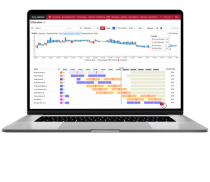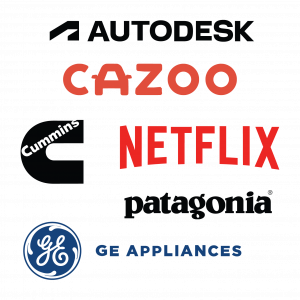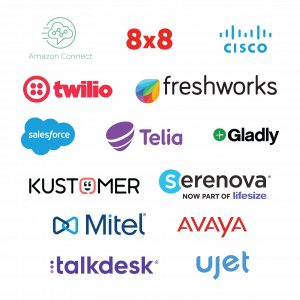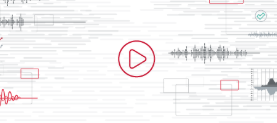Pause Before You Purchase:
Choose True-Cloud, Enterprise-grade WFO

Take Your “Cloud Upgrade” with a Pinch of Salt
To stay ahead, you know it’s time to modernize your workforce management and quality programs to be analytics driven. It’s time to move to an enterprise-grade workforce optimization suite. And for you, cloud is the future. There may seem like an overwhelming number of new and established cloud vendors to choose between. But remember, not all cloud WFO suites are created equal.
We’re here as your trusted ally to help you avoid choosing a fake-cloud deployment option or sacrificing the advanced features you need for your enterprise and contact center.
If you are looking for a true-cloud, enterprise-grade WFO suite, there is one clear and easy choice. With Calabrio ONE you never have to compromise between functionality and cloud. You get a true cloud, enterprise-grade workforce maximization, optimization and engagement suite.
Let’s look at this in context – meet the matrix that shows the value when enterprise-grade WFO is powered by a true cloud:
Want to learn what Calabrio ONE can do for your contact center in the cloud?
Flip the tiles to learn more:
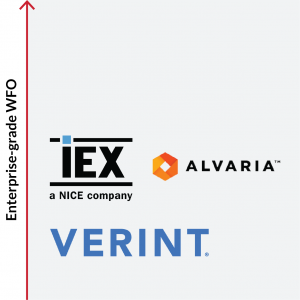
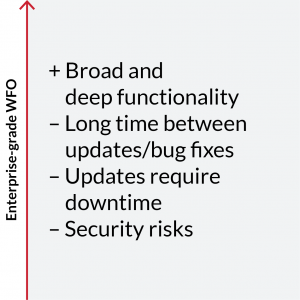
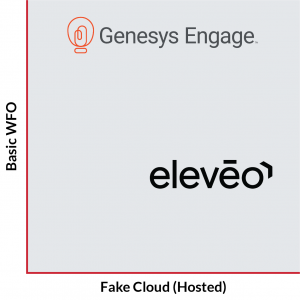
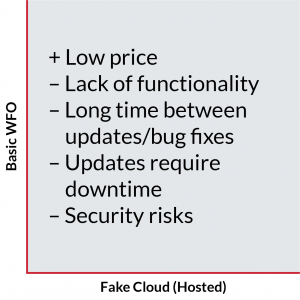
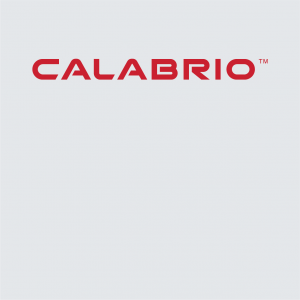
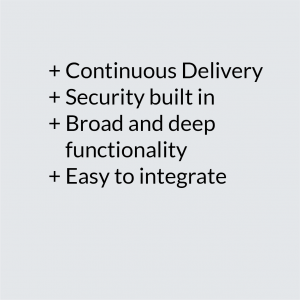
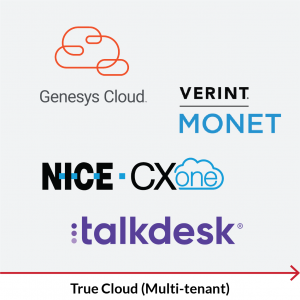
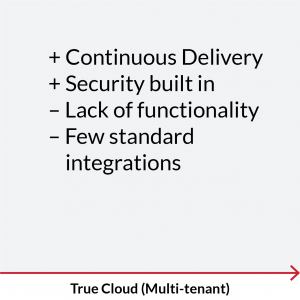
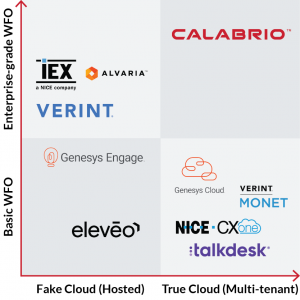
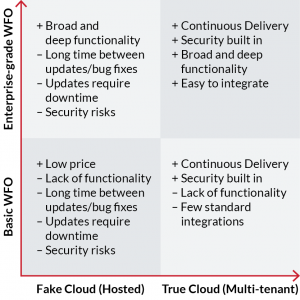
Technical Considerations
Staffing Considerations
Analytics & Reports
Communication Best Practices
Jump to section
Jump to section
True Cloud vs Fake (Hosted) Cloud: What’s the Difference and Why it Matters
You’ve decided it’s time to take your WFO solution to the cloud. That’s a smart choice—and one that reflects the accelerated number of companies moving to the cloud to put business first rather than drain focus on IT infrastructures.
But pause before you purchase because not all software offerings are created equal. There are many vendors marketing themselves as “cloud” without true-cloud solutions. Jumping at the chance to generate an additional revenue stream, many on-premises vendors proclaim that they offer cloud applications without anything to back it up. Beware.
So how do you spot the difference between true-cloud and fake-cloud solutions? And crucially, why does it matter?
Examples of True-Cloud Capabilities
| True Cloud | Fake Cloud |
|---|---|
| Multitenancy | Single tenant/hosted |
| Version-less with continuous delivery | Version locked |
| Highly secured with the latest security and compliance tools in real-time | Partially secured and often with out-of-date security tools |
| Rapid performance scaling | Limited scalability |
| High availability/ uptime – available anywhere at anytime | Not available everywhere |
| Ease of integration and extensibility | Integrations are costly and unstable |
| Easy to use with a modern, streamlined UX | Cobbled together legacy applications, all with different user experiences |
Here’s a closer look at the differences between a true cloud and fake cloud and why it matters:
In true cloud: There is one instance of the platform that serves all customers or “tenants” simultaneously, across a shared infrastructure. Just like in an apartment building, controls in the underlying code keep the tenants separate—you get your own unique, secure unit or tenant. This pooling of resources is what achieves true-cloud agility and scalability.
In a fake cloud: The solution is actually built on a multi-instance platform. In this scenario, each customer or tenant receives its own server. To scale up, new servers must be switched on manually which is costly, time-consuming, and difficult to maintain. To get the latest functionality, the latest software must be installed separately for each instance, significantly delaying your ability to benefit from new features. Even worse, some fake clouds put multiple customers on the same server and rely on organizational structure alone to keep them segregated; this is not multitenancy, it is shared tenancy and may require some features to be off-limits because the tenants would be able to see each other’s data.
In true cloud: Applications are continuously updated with new functionality and bug fixes. You can continue to use your application, without any downtime during these updates. Users can easily adapt to the incremental changes.
In a fake cloud: A few times per year, you will have several big and potentially risky updates occur. Until your vendor schedules upgrades to your environment, these bugs and issues will be pervasive for many months, disrupting your operation with significant downtime and team members needing additional time to learn about these changes.
In true cloud: Data is secured with the latest security tools, updates, and patches in real time without added cost or downtime. True clouds are hosted on the leading global cloud service providers such as Amazon Web Services (AWS) and Microsoft Azure where security is their highest priority, having nearly any certification you can think of and employing an unmatched army of experts. Here’s an example of security and vulnerability management in true cloud against Log4j.
In a fake cloud: There is no unified security among all applications and platforms. Vendors that provide fake clouds simply cannot achieve the same level of security and expertise as AWS and Azure. A fake cloud with fake multitenancy also means that providers need to defend hundreds of fortresses at the same time, instead of just one. This dilutes the time and attention that is being paid to defending your data from attack.
In true cloud: Easily scale up or down to meet the needs of your business. True-cloud solutions are built to handle rapid change seamlessly, allowing you to quickly expand your system as needed – add storage, new capabilities, and more – all while easily meeting the needs of a highly mobile and global workforce.
In a fake cloud: The vendor must have the necessary staff and hardware available to manually increase capacity or deploy new capabilities. This often requires specific technical expertise or pricey professional services which is problematic and can lead to downtime, delays in service, and reduced speed to benefit – especially when deploying in multiple time zones and geographies – all of which could negatively impact customer satisfaction.
In true cloud: Get guaranteed uptime and reliability with financial compensation if service levels are not met. You can rest easy knowing that your data is securely backed up and always available. Even if a disaster strikes one data center, another one immediately takes over with no downtime or hassle for you. All this is possible because true-cloud solutions leverage multitenant architecture and are built in the cloud with cloud infrastructure in mind.
In a fake cloud: Availability is limited by the vendor, the hardware on which their solution is installed, and who is maintaining it. Since it is often outsourced to a third-party vendor, you may not even know who is ensuring the availability of your mission-critical solutions.
In true cloud: Easily integrate your WFO solution with both cloud and on-premises solutions. True cloud solutions provide the flexibility to meet your unique business needs so integrating with external systems is straightforward, seamless, and low effort.
In a fake cloud: Integration and customization are costly and can be unstable. Hosted cloud solutions are not inherently designed for ease of integration and can end up being expensive to implement and maintain as well.
In true cloud: Applications are designed with user experience in focus. Modern web-based user interfaces make onboarding new users easier, thanks to increased access to all functionality and features. Centralized management and administration make the true-cloud WFO easy to administrate, especially if you’re a multi-site or global organization. This is only possible if your WFO suite is fully integrated with all your sites being managed from a single, centralized management console.
In a fake cloud: This can be piecemeal with some applications even requiring administrators to install and login to a desktop application. User experience will be bad, and users will have to learn multiple different user interfaces. If you’re a multi-site organization with multiple types of ACDs and integrations, be prepared for a maintenance and security nightmare.
True-cloud, enterprise-grade WFO means more functionality in the cloud. Not less.
Speak to our team to make sure you’re choosing a true cloud WFO suite that has the capabilities you need.
Enterprise Grade WFO vs Basic WFO: What’s the Difference and Why it Matters
Customer service has rapidly changed in recent years, leading to a greater need for WFO products that can aid/facilitate ever-changing demands. Some of the most significant changes to customer service include:
- Additional channels for customers to contact you in multiple ways
- Automated repetitive tasks
- Increased need for staff to continuously learn and develop a better understanding of advanced agent-handled contacts
- Greater demand to manage the shifting needs of your employees while adjusting to changing customer requirements
- Rising to the challenges of recruiting and retaining talented staff
Now, while there are many WFO products in the market, not all of them are able to meet the needs of your contact center. It’s important to differentiate between a modern, enterprise-grade WFO solution and the more basic options on the market.
See the chart below to learn more about those options and see the impact of choosing one or the other.
Examples of Enterprise-Grade WFO Capabilities
.tg {border-collapse:collapse;border-spacing:0;}
.tg td{border-color:black;border-style:solid;border-width:1px;font-family:Arial, sans-serif;font-size:14px;
overflow:hidden;padding:10px 5px;word-break:normal;}
.tg th{border-color:black;border-style:solid;border-width:1px;font-family:Arial, sans-serif;font-size:14px;
font-weight:normal;overflow:hidden;padding:10px 5px;word-break:normal;}
.tg .tg-1wig{font-weight:bold;text-align:left;vertical-align:top}
.tg .tg-pclj{background-color:#C00000;color:#FFF;text-align:left;vertical-align:top}
.tg .tg-0e6g{background-color:#C00000;color:#FFF;font-weight:bold;text-align:left;vertical-align:top}
.tg .tg-8zwo{font-style:italic;text-align:left;vertical-align:top}
.tg .tg-0lax{text-align:left;vertical-align:top}
| Functionality | Enterprise-Grade WFO | Basic WFO |
|---|---|---|
| Omnichannel optimization | Allows forecasting, scheduling, evaluations and interaction analytics across all channels to help you optimize the complete channel mix. Proven multi-skill management. | Limited omnichannel functionality, sometimes voice only. Poor multi-skill management, including inaccurate or incomplete forecasting, staffing allocation, or interaction analysis. Requires multiple applications with added cost to get enterprise-grade omnichannel optimization across the suite. |
| Contact Center and WFO Focused Business Intelligence | Fully integrated business intelligence focused on the voice of the employee and customer. | This is often not available, or not fully integrated, requiring you to learn and install an entirely new reporting application. |
| Customization | Enables you to customize and grow as your needs change. | Have to keep paying for expensive services and features to customize and get it to enterprise-grade or switch to a different platform from the same company to get those features. |
| AI-Fueled Predictive Analytics | Included to help you predict what will happen next and be proactive in coaching and training your employees. | Either it doesn’t include this enterprise-grade capability, or they charge extra for it, or force you to purchase separate tools from a 3rd party vendor. |
| Agent mobile app & self-service | Robust mobile app with agent self-service. | Lacks a mobile app or it has limited functionality. |
| Adherence Management | Handles true real-time integrations that provide immediate feedback on where resources are being utilized. | Generally lacks real-time integrations, and even when available, does not allow users to customize. |
| Self-scheduling with intraday automation | Provides employee-driven intraday automation without negatively impacting the business. | Lacks the guardrails needed to automate management of intraday schedules. |
Let’s take a closer look at the difference in capabalities between a modern, enterprise-grade WFO solution and a basic WFO solution:
Omnichannel Optimization
Making it easy for your customers to interact and engage with a contact center in multiple ways – phone, chat, email, text, etc. – is vital for any organization yet basic WFO solutions either make this difficult to manage or they charge extra for these key capabilities:
Enterprise-grade WFO: Provides a rich set of pre-built connectors to the most common CCaaS, ACD, CRM and HR-platforms and APIs to build custom integrations. This gives enterprise customers the freedom to integrate the full contact center stack for complete optimization across all channels and support systems. An enterprise-grade WFO suite also offers the ability to self-serve in editing and configuring integrations.
Basic WFO: Basic WFO: Has limited integrations to only certain customer experience (CX) platforms, leaving you with blind spots and siloed, manual management of non-integrated channels.
Enterprise-grade WFO: Can be used to forecast for various channels such as social, email, chat, text and more. Omnichannel interactions can be forecasted and appropriately scheduled, with forecasting tools that enable concurrency for agents handling multiple chats. Multi-skilled agents benefit from a robust resource allocation method, allowing schedulers to accurately create schedules that handle both single-skilled and multi-skilled agents.
Enterprise-grade WFO provides the ability to import, export data to and from external sources, select multiple historical datasets as an input to forecasting, forecast and schedule down a 15-min interval level. It applies seasonality patterns through complex algorithms and allows users to highly customize inputs and outputs. Shrinkage can be dynamic and automated, which results in far more accurate planning. Finally, advanced solutions allow you to run forecasts and schedules in multiple “what if” scenarios. Scheduling can handle labor laws from any country thanks to the highly configurable work rules, making scaling up your business a possibility.
Basic WFO: Relies on basic forecasting methods that can only utilize limited historical data, most times 1 week. Shrinkage is a fixed number that cannot be customized by interval, let alone be automated, in turn hurting the accuracy of planning and increasing the manual work planners must put in. Users are unable to run multiple scenarios and lack the customization of inputs and output. They generally can only forecast at a 30-min interval and can’t handle multi-skilled agent in an omnichannel environment.
Without the needed configuration options, you will simply reach a less accurate forecast to build your schedule from. Planners will further have to adapt your schedule practice to the way the basic WFO operates, instead of optimizing the schedule the way you want. Work rules are simplistic and automatic scheduling only runs one week, isolated, at a time. Basic WFO platforms lack the possibility of optimizing breaks and activities, relying on manual labor to handle daily changes needed to adapt to a constantly changing environment. Editing schedules in bulk is not possible and planning large meetings or training is incredibly labor intensive. The result is increased operational costs or decreased service for your customers.
Finally, there is no functionality to handle seniority or performance-based scheduling to let associates bid on desired schedules, and instead having contact center leadership teams assign schedules manually, lowering employee engagement due to optimal processes not being supported.
Enterprise-grade WFO: Makes it easy for your quality team to do their job. With one-click they have access to view, playback, evaluate, analyze and coach omnichannel interactions. You won’t pay extra to record different channels and they won’t have to click on multiple tabs or jump to multiple windows to perform evaluations. Your quality managers are busy and do not have time for complicated, inefficient tools that make their job harder.
Basic WFO: Quality solutions can give evaluators a headache and anxiety by making it hard for them to access and use the quality assurance tools they need throughout the day.
Enterprise-grade WFO: Enterprise-grade WFO: Takes what can be overly complicated and makes it practical and usable. With enterprise-grade WFO analytics tools you get access to speech, desktop and text analytics all in one user-friendly solution for true business value.
Basic WFO: Basic WFO: Lacks analytics capabilities. Sometimes this means you will get access to basic voice transcriptions only. To get true insights on customer and employee experience you will be forced to buy separate applications that are loosely integrated with multiple user interfaces. This makes interaction analytics complicated, siloed and expensive.
Enterprise-grade WFO: Makes it easy to automatically combine omnichannel data from across the WFO suite and across the enterprise for a complete visualization of the customer journey. Enterprise-grade WFO provides self-service business intelligence for all channels that anyone can use – from the frontline of the contact center to business users, and on to the boardroom. With enterprise-grade WFO you’ll spend less time creating reports and dashboards and more time using them to drive continual improvements.
Basic WFO: Offers basic reporting. Full-suite omnichannel WFO reporting and business intelligence is either not available or offered as a separate, expensive, and complicated add-on product. This forces you to integrate, manage, and learn yet another reporting solution.
Innovative Solutions
Enterprise-grade WFO: Vendors help you customize your solution to your specific business requirements during implementation and give you the tools and resources needed so you can further customize and optimize the solution as your business grows and your needs change. No need to deal with the hassle of going back to the vendor and paying for costly, time-consuming professional services or additional products.
Basic WFO: Will take you only so far and then make it complicated when your needs change or you have additional enterprise-grade requirements such as encryption, custom metadata, live monitoring, screen recording, bulk export, omnichannel recording, omnichannel analytics, PCI compliance, automatic multi-skill scheduling, schedule adherence to work policies, meeting and training planning etc.
Enterprise-grade WFO: Gives you the tools to predict what will happen next and be proactive in coaching, training and scheduling your employees. It helps you identify trends and the outliers such as rockstar agents, underperformers and overstaffing.
Basic WFO: Either doesn’t offer this enterprise-grade capability, will charge you extra for it, or force you to purchase separate tools from a 3rd party vendor. Again, this makes it more difficult to manage the solution and for users to do their job.
Enterprise-grade WFO: Has a focus on true business intelligence that is centered on the contact center and WFO. You need dynamic, customizable, drill-through dashboards and data-visualization tools that are fully integrated with your WFO suite so you can quickly get the voice-of-the-customer business insights you need without having to go through your IT team.
Basic WFO: Offers canned reports by application and makes it complicated to automatically tie together and visualize the voice of your customer and agent. These kinds of questions remain unanswered: What is the impact that agent adherence has on quality scores? What impact does the current marketing campaign have on call volume, handle time and agent satisfaction?
Enterprise-grade WFO: Includes a mobile app with all the functionality an agent can access on their desktop to give agents freedom to view schedules, be notified, review performance, build their own schedule, make overtime, vacation and schedule change requests, trade shifts and other tasks, wherever they are.
Basic WFO: Either completely lacks a mobile app or has a simplistic schedule viewer without any possibility for agents to provide input. Sometimes Basic WFM-vendors point customers to a separate agent mobile add-on with different technology or 3rd party technology, leading to a completely different user experience when it is cobbled together with the Basic WFO. Even though some may a good User Interface, they completely miss on scheduling principles such as rotations and optimization.
Enterprise-grade WFO: Allows a customer to set up alarms and notifications related to the adherence of agents. They are capable of handling true real-time integrations that provide immediate feedback to contact center leadership team on where resources are being utilized.
Basic WFO: Generally lacks in real-time integrations, and even when available, does not allow users to customize alerts and rules of adherence, edit historical adherence exceptions, or even view detailed states.
Enterprise-grade WFO: Allows a customer to set rules and thresholds to automate intraday schedule management. Agents can equally manage and change their own schedules, creating more flexibility in contact center operations and helping businesses better tackle agent stress.
For example, agents can add work hours on an unscheduled or scheduled day or move their breaks and lunches themselves as unexpected things happen throughout each day without negatively impacting the contact center’s service level. Agents also have the ability to request time off and for it to be automatically processed without impacting contact centers KPIs, meaning agents receive immediate feedback on the status of their request. Similarly, they can trade their shifts with others via automatic approvals.
Basic WFO: May allow a limited set of self-service features for agents, but lack the guardrails needed to automate management of schedule change requests. This leads to risks to service levels or manual processing, which frustrates supervisor and agents, and makes it impossible to use at scale. There are no thresholds to automatically determine over and understaffing.
Best of All, We Make it Easy for You to Switch
We get it, switching to a new vendor can seem intimidating, but don’t fall into the trap of upgrade convenience. In fact, switching vendors is not much different than moving from on-premises to cloud, you will have a transition project, regardless of vendor. So why not pick the partner who will offer you both the best support while moving you to a superior cloud product?
Calabrio is here to help by making it easy on your budget and your IT team – and we’ve got the experience to prove it. So why risk losing out?
.tg {border-collapse:collapse;border-spacing:0;}
.tg td{border-color:black;border-style:solid;border-width:1px;font-family:Arial, sans-serif;font-size:14px;
overflow:hidden;padding:10px 5px;word-break:normal;}
.tg th{border-color:black;border-style:solid;border-width:1px;font-family:Arial, sans-serif;font-size:14px;
font-weight:normal;overflow:hidden;padding:10px 5px;word-break:normal;}
.tg .tg-fymr{border-color:inherit;font-weight:bold;text-align:left;vertical-align:top}
.tg .tg-0pky{border-color:inherit;text-align:left;vertical-align:top}
| Remove the Financial Barriers | Fast, Seamless Transitions | Proven Track Record for Integration |
|---|---|---|
| Cost can be a barrier when it comes to making a much-needed move to the cloud. We want to make it easy on your budget, and your nerves!
With our current Move to Cloud promotion, moving to true-cloud, enterprise-grade WFO with Calabrio ONE has never been easier. For a limited time we’re waving the implementation fee and we’ll help with your current subscription or support fees.* Speak to our sales team to learn more *Offer valid for a limited time. Some conditions apply – speak to your sales representative for details. |
When you move to cloud, we know you don’t want a lengthy, disruptive process but a swift move. Our world-class support and implementation teams can get you up and running quickly.
See how customers were able to: 1. Move entire telephony infrastructure to the cloud in 3 days with Calabrio 2. Enable 4X increase in contact center size with Calabrio WFO cloud automation These leading brands put their trust in Calabrio. |
Moving to the cloud should create flexibility not limitations. We make sure you never have to compromise. Calabrio ONE seamlessly integrates with leading CRM, ACD and CCaaS vendors.
Since 2016 we’ve implemented Calabrio ONE Cloud with these leading vendors for thousands of customers. |
Questions to ask your vendor
Here is a checklist of eight questions to quickly unearth if the vendor you’re in conversation with is offering you a true-cloud suite, or a fake:
- How often do you provide updates and new functionality?
- Will I have downtime when you update my tenant?
- In my tenant, will my data be totally isolated from other tenants?
- Will I have downtime when you update other customers in your cloud?
- How often are your security tools updated?
- How quickly did you fully remediate your customers when the Log4J vulnerability was announced?
- Do you have a Service Level Agreement (SLA), and what happens if it is not met?
- Is there a single user interface for your WFO suite?
Don’t let vendors pull the cloud over your eyes.
Speak to our team to make sure you’re choosing an enterprise-grade WFO suite that is true cloud.
Security and log4j example
Information security is a top priority at Calabrio. When vulnerabilities such as log4j are discovered, Calabrio has systems and incident response plans in place to react quickly to these types of situations in order to minimize risk and disruption to Calabrio customers.
With log4j, as soon as the vulnerability was identified, we initiated our incident management process and activated the Calabrio Emergency Response Team. Our immediate focus was to assess and mitigate any potential impact of this vulnerability on Calabrio and our customers. We quickly determined that neither Calabrio nor any Calabrio customer systems were compromised during this incident.
Calabrio Trust Site
Availability and how we monitor the most important services to ensure we are always available for any user who needs functions
Calabrio has a robust number of measures in place to meet your organization’s business continuity standards. Calabrio’s overall business continuity and crisis plan measures are based on a strategic framework and underlying analysis. Those measures include:
- Built-in high availability via server redundancy
- Built-in anti Distributed Denial-of-Service (DDoS) mechanisms
- Automatic monitoring and alerting to Calabrio’s cloud team for proactive action
Calabrio continuously monitors the service and collects information about usage and service health, such as up-time, security breaches, and performance.
Analytics
MONITOR PERFORMANCE AND KEEP EMPLOYEES ENGAGED WHEREVER THEY RESIDE
Listening to customer calls right now to find trends probably sounds overwhelming. Are you curious how your agents are handling being at home? Are you wondering how your customers are reacting? Analytics can take away some of that burden.
- Sentiment Analysis Dashboard: This is a pre-built dashboard to help give a score of positive, negative, neutral, positive score to 100% of your call interactions coming into the contact center. This information also displayed within the media player, so you can quickly spot statements within a call by sentiment.
- NPS
- Evaluation Scores

Additional Resources

Webinar: Managing Change in the New Reality
Change management has suddenly become a major priority. Is it baked into your contact center strategy? Watch the webinar to learn more.

Webinar: Resources to Help Make Remote Work Actually Work
Learn more about companies are managing fully remote workforces for the first time.

Webinar: How to Use Analytics to Manage and Respond to Crisis
Many of our customers are experiencing a significant increase in customer interactions, as well as new challenges associated with agents working remotely.

Webinar: Best Practices for Keeping Remote Employees Engaged
As your brand’s voice on the front line, it’s imperative to find new and unique ways to keep your remote agents motivated to maintain performance and deliver quality customer care.

Ebook: Best Practices for Enabling Agents to Work from Home
Download our new Ebook to learn Calabrio application-specific checklists and best practices to ensure your agents have a successful work from home experience and continue to provide exceptional customer service.

Webinar: Delivering Great Customer Experience in a Work-From-Home Environment
In this period of disruption and uncertainty, it’s never been more important to be focused on your customers and employees.

Webinar: Rapidly Moving to a Work-from-Home Model in Your Contact Center
In this webinar on demand, Calabrio experts answer your most pressing questions, from dealing with bandwith issues to ensuring agents are still working while at home.

Calabrio Success Center Resources: COVID-19
In response to current events, we’ve created dedicated forums for you to share experiences, and have launched a COVID-19 Resource Center on the Calabrio Success Center for you to easily access these evolving resources.

Datasheet: Q&A on Using Analytics to Manage and Respond to Crisis
Calabrio hosted a webinar on how to use analytics to manage and respond to crisis. We hope this collection of common questions will help develop your analytics strategy in this challenging time.

Webinar: Navigating Data Security and Compliance in a Remote Workplace
To learn more about identifying and mitigating security risks in a remote workforce setting and best practices in unconventional times, we hosted a webinar and open Q&A session.

Datasheet: Q&A on the Rapid Shift to Work-from-Home Model for Contact Centers
We fielded dozens of questions from attendees of a webinar on work-from-home model (WFH) strategies for contact centers and have created this resource to address many of your concerns.
BLOG POSTS

Flexible Working:
A 3 Point Plan
Flexibility in contact centers means many things to many people. It usually means making life easier for agents, enabling them to strike the all-important work/life balance.

How to keep your remote agents connected and engaged
If you are looking for ways to engage your remote employees (or brick and mortar) here are a few tips to get you on your way

If You Love Your Agents Set Them Free
The morning grind. The daily commute. Rush hour. These days, the colloquialisms we use to refer to our workday travels don’t need to hold true.
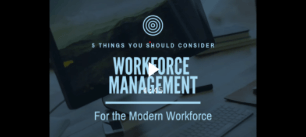
5 Important WFM Software Considerations
What should you consider when evaluating new workforce management (WFM) software? Watch this video to learn five things in WFM that you may not realize make a big difference in managing your contact center.

Rethinking Workforce Management
As contact center professionals, we all understand the importance of workforce management tools and processes in ensuring that we have enough agents to work each shift.

4 Ways to keep your contact center agents engaged
Those who work in the contact center understand a very different truth: engaged, experienced contact center agents are more important than ever

How to keep your remote agents engaged
Today, people want to work their own hours, choose where they work and do so without the restrictions of formal direct supervision in a traditional office setting.
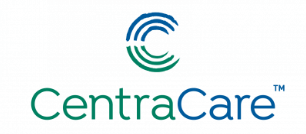
Anytime Anywhere Visibility
CentraCare uses Calabrio ONE to permit visibility into forecasts and schedules, use different scheduling types for different needs, and ensure consistent customer/patient service.
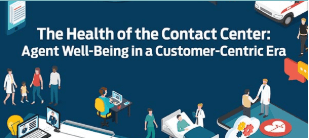
The Health of the Contact Center
In today’s competitive landscape, brands are recognizing that creating a first-rate customer experience is a significant differentiator and the key to establishing customer loyalty.

Flexibility is key
With customer expectations at an all-time high, brands have never been under more pressure to deliver a great customer experience

The Definitive Primer on Employee Engagement
There’s a massive shift underway in today’s contact center: yesterday’s focus on workforce optimization (WFO) is morphing into a new focus on employee engagement.
VIDEOS
Tips for QM with Remote Workers
Quality Management is an important tool to not only help you monitor agent and call performance regardless of where the agents sit
Empower Remote Agents with Workforce Management
COVID-19 has highlighted the need for workplace flexibility as more employees work from home and are faced with other constraints such as school closures and childcare.
Technical Tips for Enabling Remote Agents
As you’re preparing for some or all your workforce to work from home, there are some best practices we encourage you to follow
Quality Management – Last Date Time of a contact by a person
This video covers how Quality Management users can build a quick and easy report to ensure their agents are being recorded properly.
Using Desktop Analytics to Spot Slow Downs with Remote Agents
Desktop Analytics offers insights into agent activity and allows managers to discover and help fill educational gaps when needed.
How to use WFM to Empower a Remote Workforce
Has your team transitioned to a remote / work from home model? Learn how to creatively use Calabrio WFM and Calabrio Teleopti WFM features.
